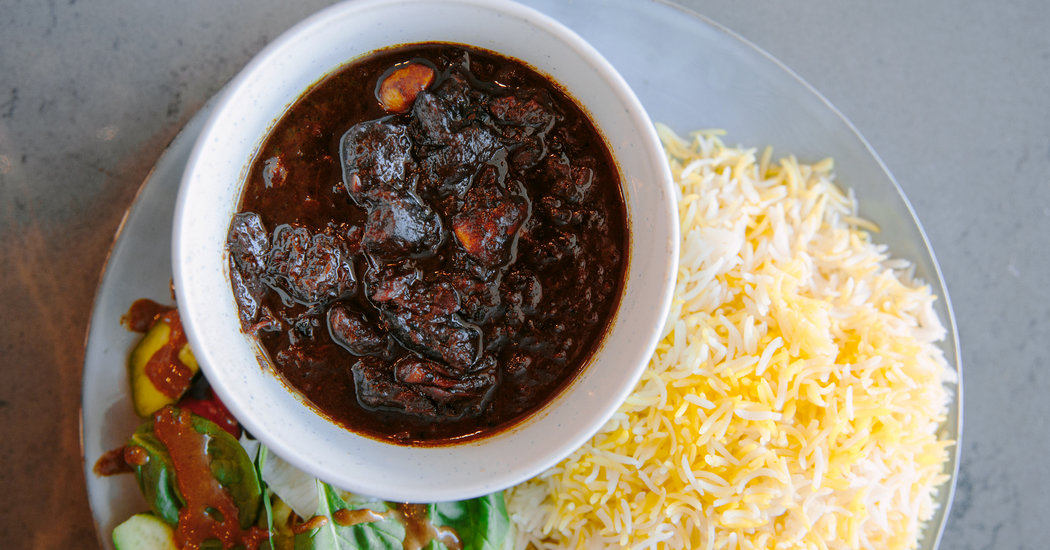
BRISBANE, Australia — There’s something about the Iranian dish fesenjan that tastes elemental, as if it might secretly be one of the building blocks of the universe. The stew’s combination of walnut and the sweet-tart high frequency of pomegranate has the capacity to work its way into the crevices of your soul. At its best, the color is tawny, almost black, the chicken pieces cooked in such a way that the dark sauce becomes one with the bird, a great warming morass of nutty-meaty-fruity wonder.
Great fesenjan is not easy to find — often it’s too sweet, too light or not available at all. Especially in kebab-obsessed Australia, many Persian restaurants forgo Iran’s many complex stews altogether, knowing that grilled meat on skewers rules the day.
So it was thrilling to find a bowl of beautiful stew in a simple neighborhood cafe in Brisbane’s inner suburbs. The Little Persian Cafe is just that: a small room with glass doors that open to the sidewalk. It sits on the main drag of Hamilton, an affluent neighborhood that hugs the Brisbane River.
I’ve found it difficult in Brisbane, in particular, to find the best everyday food — the local gems, the small edible wonders that make living in any city more pleasurable. It’s not that they don’t exist; it’s that they’re so rarely celebrated. Most guides list the same 40 or so restaurants, all of them trendy or expensive or both. Those places are fine, and some are better than fine, but the fesenjan at the Little Persian Cafe is vastly better than most of the food you’ll find on those lists.
The front counter is built mainly to support an espresso machine, which gives the cafe its primary purpose for a few hours each morning when commuters stream through to get their coffee fix on the way to work. For the rest of the day, it is fairly quiet, with only a handful of customers stopping in to sit and eat. The menu is written on a blackboard wall that frames the open kitchen in back. If you come during an especially slow time, you might have to stick your head into the kitchen to alert the owner or her mother that you’re there.
Australia’s obsession with espresso has provided an obvious entry point for new restaurateurs. If you can make a decent flat white, that guarantees a customer base upon which a business might survive. Fittingly, the cafe has become the latest place where immigrant chefs present the food of their homelands, much as the milk bar or the fish-and-chips shop did in decades past. I’ve had some of the most interesting Colombian, Japanese and now Persian food in spaces that also operate as standard Australian neighborhood cafes.
The Little Persian Cafe, which opened in 2016, is owned and operated by Sarah Nowroozzadeh with help from her mother, Tara Sathali. Ms. Nowroozzadeh was born in Australia; her parents immigrated from Iran in 1978. For years, the family ran a takeout seafood restaurant — a fish-and-chips shop — on the same site where the cafe now stands. When the landlords tore down the old building and built a new development, the family decided to do something different in the space.
For breakfast, they serve some classic Australian cafe fare: avocado toast; ham-and-cheese toasted sandwiches, commonly known as toasties. There’s also a Persian omelet, filled with onion and tomato and a spice blend that Ms. Sathali came up with, and soft Persian potato cakes served with carrot purée, a poached egg, a pile of bacon and fantastically light Persian flatbread bubbled with char.
The bread, from a local Persian bakery, is one of the many wonders of this place. (It comes with dips at dinnertime: mast-o-moosir, made with wild green garlic; or mirza ghasemi, with a base of charcoal-cooked eggplant.) And it accompanies the fesenjan and the ghormeh sabzi, a deeply intense lamb stew that tastes like the color green cooked down to its grassy herbal essence.
Ms. Nowroozzadeh also makes a variety of sweets in-house, including coconut and walnut cookies with a crust that’s almost stretchy and an interior so delicate they take on an ephemeral quality.
The kind of care and talent on display at this modest cafe is rare. After I ate my first bowl of fesenjan here, I became newly obsessed, and have since visited every Persian restaurant I can find, in Brisbane and beyond.
Time and again, I come across grand rooms swathed in brocade, grilled meats that are slightly too dry, leaden breads, and fesenjan that pales in comparison. (Ms. Nowroozzadeh guesses that this is perhaps because others don’t put in the six to seven hours’ cooking time that her family recipe requires.) Even the rice at the Little Persian Cafe is superior, its hint of saffron quiet and persistent and true, unlike the dyed yellow stuff I find elsewhere.
If there’s a downside to all this care, it’s that the food can take a long time to arrive, and the atmosphere is as casual as a restaurant can be. This is a true family operation. One day, Ms. Nowroozzadeh closed up shop early; she had a funeral to attend, and because her mother was going with her there was no one to run the cafe.
It didn’t bother me. I came back the next day. I’d wait 24 hours or more for that fesenjan, and feel lucky for the privilege of doing so.
Do you have a suggestion for Besha Rodell? The New York Times’s Australia bureau would love to hear from you: nytaustralia@nytimes.com, or join the discussion in the NYT Australia Facebook group. Read about the Australia Fare column here.
Follow NYT Food on Twitter and NYT Cooking on Instagram, Facebook and Pinterest. Get regular updates from NYT Cooking, with recipe suggestions, cooking tips and shopping advice.




